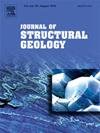The latest surface rupture along the western segment of the Qilian–Haiyuan fault and its implications
IF 2.9
2区 地球科学
Q2 GEOSCIENCES, MULTIDISCIPLINARY
引用次数: 0
Abstract
The Qilian‒Haiyuan fault is a boundary fault with strike slipping in the Qilian Shan (Shan means mountain or mountain range in Chinese) on the northeastern Tibetan Plateau. Several strong earthquakes (M ≥ 7) have occurred in this fault zone, and the risk of future major earthquakes is highly concerning. We identified a seismic surface rupture zone of unknown age at the Halahu fault, which is located at the western end of the Qilian‒Haiyuan fault. The Halahu fault plays a crucial role in structural transformation at the westernmost point of the Qilian‒Haiyuan fault zone, and historical seismic records are vital for assessing the future seismic risk associated with the fault. We found via field investigation that the existing length of the rupture zone is more than 24 km, which is characterized mainly by cracks, the offset of the trench, and the offset of terrace edges. Twenty-eight left-lateral coseismic offsets were determined using field measurements and UAV image analysis, with a minimum offset of 0.6±0.1 m and a maximum offset of 2.5±0.2 m. Historical earthquake records confirm that the surface rupture zone was caused by the M6½ earthquake that occurred east of Hala Lake on July 14, 1930 east of Hala Lake; however, the magnitude of that earthquake should be revised to be approximately M6¾ on the basis of field survey data. Research has shown that major earthquakes have shifted from the Bayan Har active block to the Qinghai‒Tibet block boundary fault zone. This study identified and dated earthquake surface rupture zones, offering essential guidance for future research and assessments of fault earthquake risk. Our results indicate that the Halahu, Tuolaishan, and Jinqianghe‒Laohushan faults have high potential for strong future earthquakes.
祁连-海原断裂西段最新地表破裂及其启示
祁连山-海原断裂是青藏高原东北部祁连山(山的意思是山或山脉)的一条走滑边界断裂。该断裂带已经发生了几次强震(M≥7),未来发生大地震的风险令人高度关注。在祁连-海原断裂西端的哈拉胡断裂上,确定了一个年龄不详的地表地震破裂带。哈拉胡断裂带在祁连-海原断裂带最西端的构造转变中起着至关重要的作用,历史地震记录对评估该断裂带未来地震风险具有重要意义。野外调查发现,现有断裂带长度超过24 km,主要表现为裂缝、海沟偏移和台地边缘偏移。通过现场测量和无人机图像分析,确定了28个左侧同震偏移,最小偏移量为0.6±0.1 m,最大偏移量为2.5±0.2 m。历史地震记录证实,地表破裂带是1930年7月14日发生在哈拉湖以东的M6½地震造成的;然而,根据实地调查数据,该地震的震级应修改为大约M6¾。研究表明,大地震从巴颜喀尔活动地块向青藏地块边界断裂带转移。本研究确定了地震地表破裂带的年代,为今后断层地震风险的研究和评估提供了重要的指导。结果表明,哈拉胡断裂带、沱来山断裂带和金强河—老虎山断裂带未来发生强震的可能性较大。
本文章由计算机程序翻译,如有差异,请以英文原文为准。
求助全文
约1分钟内获得全文
求助全文
来源期刊

Journal of Structural Geology
地学-地球科学综合
CiteScore
6.00
自引率
19.40%
发文量
192
审稿时长
15.7 weeks
期刊介绍:
The Journal of Structural Geology publishes process-oriented investigations about structural geology using appropriate combinations of analog and digital field data, seismic reflection data, satellite-derived data, geometric analysis, kinematic analysis, laboratory experiments, computer visualizations, and analogue or numerical modelling on all scales. Contributions are encouraged to draw perspectives from rheology, rock mechanics, geophysics,metamorphism, sedimentology, petroleum geology, economic geology, geodynamics, planetary geology, tectonics and neotectonics to provide a more powerful understanding of deformation processes and systems. Given the visual nature of the discipline, supplementary materials that portray the data and analysis in 3-D or quasi 3-D manners, including the use of videos, and/or graphical abstracts can significantly strengthen the impact of contributions.
 求助内容:
求助内容: 应助结果提醒方式:
应助结果提醒方式:


